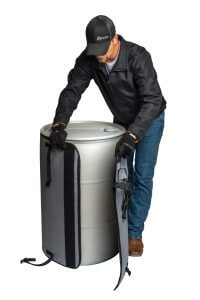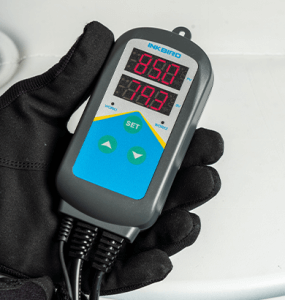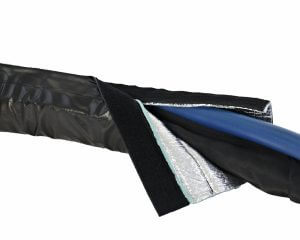For spray foam insulation companies, winter means one of two things. Most of them keep spraying and do everything they can to keep chemicals warm, while others thoroughly winterize and store their rigs. Either way, here are some great things to consider.
If you’re going to keep spraying, controlling drum and hose temperatures is critical. Every year this season brings countless troubleshooting calls stemming from cold material in the barrels. The three main ways to handle this in a spray foam rig is the trailer space heater, keeping drums elevated off the floor, and using drum heaters/blankets. There have been many different designs in the past, but they have been plagued with problems like having fixed temperatures with no ability to control, runaway heating elements, poor craftsmanship, faulty wiring, poor fastening/improper fit, or just plain bulky. We’ve even seen them create a hotspot that baked the protective coating off inside the drum and clogged up the filters.
Knowing these challenges, and that Suburban Manufacturing Group made such a great product with their Sidewinder Hose Cover, it made sense for them to take their expertise to develop a better drum warmer. Well, they made one and when we saw it, we were so impressed we made it our featured spray foam accessory through the end of the year. Check out the video for yourself. The integrated temperature control with digital read out, superior insulation, rugged material, durable closure system, and dreamy price tag, make it the best gift you can get your rig this year.
Mothballing or Storing a Rig
If you’re not using your rig this winter or decommissioning a rig for any reason, here is a list of key steps to help you through the winterizing process:
- Get every bit of ISO out of the hoses to avoid catastrophic failure or complete hose replacement
- B side is not as reactive but can be corrosive to certain types of metals and plastics. Since not everyone has the same equipment, you probably should flush it out as well
- Be VERY careful what chemical you use to flush ISO from the system. Many solvents and liquids have trace amounts of water in them which can cause the ISO to crystalize. IDI recommends using an ISO-neutralizer like NZD ISO FLUSH from Global Specialty Products
- When ordering flush, get at least three times what your system holds. For example: if you have a 15’ supply hose and 210’ of spray hose, you’ll have around 2.5 gallons in each side of your system. This means it will require at least 8 gallons per side or approximately 15 gallons for purging both sides of the equipment
- You want every trace of ISO purged from the lines. Make sure you see nothing but clean solvent coming out of the system before moving on. When only clean solvent is coming out, begin recirculating by flushing the system back into the bucket you’re pulling from
- Don’t forget about the return line. Everything with ISO in it needs to be purged and cleaned… Everything.
- When you’re done, flush out the flush. Follow the NZD ISO FLUSH with a long-term storage fluid-like SURF A LUBE. This product is designed to sit in the lines and will not damage your machine seals and packings
- Remove transfer pumps from drums, clean off residual SPF liquids (if any), and place in a tube or sleeve filled with SURF A LUBE. A capped PVC tube works great for this. Seal drums tight and store them properly
While some of this may seem daunting, you can do it and we can help. IDI technicians are always ready to answer your call and help you protect your investment.
So, if you are spraying this winter be sure to check out the new Python Sidewinder Drum Heater. If you’re taking this season off or parking your rig for a while, be sure to flush it thoroughly. For more information on the new drum heater or any of IDI’s products, contact your local branch or check out our online flyer for more benefits of this state-of-the-art product.
For more tips on how to get through the winter months with less stress, contact your regional Tech Service Rep and take a look at this blog from years past.


